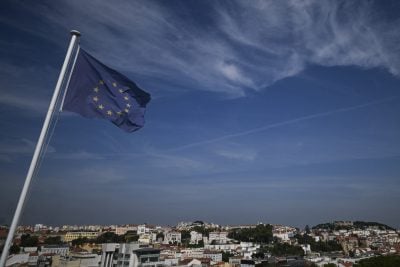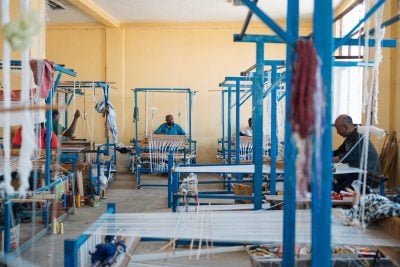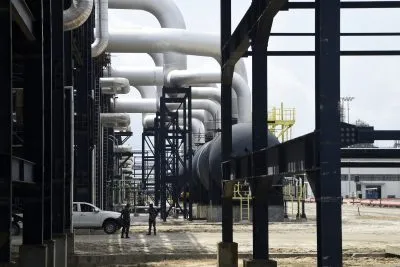After Egypt’s hosting of the UN Climate Change Conference (Cop27) in the resort city of Sharm El-Sheikh in November, President Abdel Fatah al-Sisi may look back on the country’s moment in the limelight with a mix of satisfaction and mild irritation.
Sisi successfully used the summit to boost his country’s diplomatic standing. It reached an historic agreement on a “loss and damage” fund to compensate developing countries for climate change, but many global media headlines focused on demands for the release of British-Egyptian activist Alaa Abdel Fattah and the wider story of an estimated 65,000 political prisoners believed to be languishing in Egyptian jails.
Nevertheless, Sisi and his government will look back on several major highlights. As well as playing proud host to “Africa’s Cop”, the first Cop summit on the continent for five years, the president used the glow of the summit to focus on building trade alliances with major international partners.
He sealed a valuable handshake with US President Joe Biden worth $500m in deals for the development of solar and wind projects in Egypt, while a number of other valuable green deals were concluded (see below). They come at a time when Egypt faces an uncertain fiscal climate. While the IMF predicts that GDP growth will increase to 6.6% this year – a decent recovery from just 3.3% last year – mounting debt levels are spooking markets.
Rising levels of debt
External debt reached nearly $158bn by September 2022, and total debt is predicted to reach $557bn by 2026. Meanwhile, the country has $6bn of upcoming debt maturities next year, and a further $9bn in 2024. The Covid-19 pandemic and the Russia-Ukraine war have taken a heavy toll on the economy, and investment levels have fallen below sub-Saharan Africa and MENA averages, accounting for only 12.23% of its GDP in 2021.
As a result of these economic developments, the newly appointed governor of the Central Bank of Egypt, Hassan Abdullah, has held meetings with the IMF, six years after the country last agreed a bailout under an Extended Fund Facility.
By the end of October, after months of negotiations, Abdullah was granted a $3bn loan package to be disbursed over four years – less than the country wanted, according to reports in online newspaper Mada Masr, due to the government’s reluctance to relinquish government and military control of the private sector and reduce its large subsidy bill.
For Khalil al-Anani, a senior fellow at the Arab Center Washington DC (ACW), the IMF loan is a drop in the ocean, and will be solely used to pay for “luxurious and unnecessary megaprojects”, including the building of a $59bn new administrative capital 45km east of Cairo. Writing on the ACW blog, Anani says that the policy of ploughing funds into such projects has not only failed but also necessitated further bailouts.
“Sisi naively believed that his megaprojects would improve the economy to such an extent that they would pay back all of these debts. However, he was wrong. The Egyptian economy became more reliant on external funds and entered a vicious cycle of foreign debt accumulation, which has now brought the country to a critical juncture that might end with it entering bankruptcy.”

The winding road to privatisation
Against the worsening fiscal backdrop, the IMF’s demands for reduced state intervention in the economy come as no surprise. For years, the institution has been encouraging the Egyptian state to unleash private sector growth, in an economy largely dominated by powerful military-owned enterprises.
In recent months, the government has been forced to pay lip service to the possibility. In June, it released a state ownership policy document, which presented a framework for strengthening the role of the country’s private sector. Decisions are to be made on whether to retain or exit state-owned assets over the next three years.
However, analysts say that the document does not signal an end to state and military control of the economy.
“It looks like the plan is to secure private investment while keeping the companies under management by Egypt’s sovereign wealth fund,” says Yezid Sayigh, a senior fellow at the Carnegie Middle East Center in Beirut.
“It is highly significant that capitalisation is being sought via the sovereign wealth fund, and not the Egyptian Stock Exchange, since the latter would require full disclosure of the companies’ financial data and also allow shareholders meaningful control – both of which appear to be rejected by the military,” he says.
Still, under the government’s plans 10 state-owned and two army-owned companies should be privatised, and two holding companies grouping the country’s seven largest ports and a number of hotels may be formed.
Egypt’s bonds strategy
While widescale privatisation is likely to be kicked into the long grass, Egypt is exploring other ways to drum up global investor interest, including positively re-engaging with lenders.
Last January, Egypt returned to the JP Morgan Emerging Market Bond Index, 10 years after its exit in June 2011. This inclusion signalled “the confidence of the foreign investment community,” and put the country “on the international radar as an investment destination”, said Egypt’s Ministry of Finance.
This looks like part of a concerted strategy to return to borrowing on foreign debt markets by offering new bonds and treasury bills. Egypt’s new bond strategies aim at diversifying the country’s financial resources and targeting large bond markets of major economies.
“Bonds denominated in other currencies, such as the Chinese yuan, are part of a variety of initiatives that should enhance their ability to meet debt obligations and attract further funding,” says Mitchell Diedrick, foreign exchange dealer at AZA Finance.
In March, Egypt became the first country in the Middle East to raise money on the Japanese market with the issuance of Y60bn ($500m) worth of “samurai bonds” – yen-denominated bonds issued by foreign governments. The government is now considering issuing a set of green samurai bonds.
Carbon trading schemes go ahead
On the sidelines of Cop27, the Egyptian Stock Exchange announced it would launch Africa’s first voluntary carbon market by mid-2023. When fully deployed, the market will allow Egyptian and other African companies to enter into a global emissions trading scheme whereby companies can offset emissions by buying carbon certificates from companies with a smaller footprint.
Twenty-eight Egyptian solar energy companies operating in the Benban Solar Park – the fourth largest in the world – are already negotiating with international companies to sell carbon certificates and stand to make around $7m from sales. If the trend goes forward, Egyptian companies operating in major power plants across the country, such as the Zafarana and Gabal al-Zeit wind farms, stand ready to benefit.
While critics argue that such offsets don’t reliably reduce emissions, Egypt aims to use the process to foster a green economy, a process accelerated by deals struck at Cop27.
Cop’s green legacy
Investment pledges made at Sharm El-Sheikh have boosted the country’s green finance credentials. Alongside South Africa, Egypt is Africa’s biggest market for renewable energy asset finance, accounting for $5bn of investment between 2017 and 2021, says Bloomberg’s Climatescope report. Cop27 shone a light on the range of financial opportunities available in Egypt’s green industry, offering a boost to growth and a way of tackling the debt crisis.
Debt-swap initiatives have been arranged with partners such as Italy and Germany to boost green project development while reducing the debt pile. Under such agreements, Egypt’s creditors would gain an equity position in green projects in exchange for the cancellation of Egypt’s debt.
Egypt’s minister of international cooperation, Rania Al-Mashat, held a bilateral meeting with German representatives resulting in €250m ($258m) support for green energy projects, including €150m in development grants and debt swaps. This builds on deals struck in 2020, when Egypt and Italy signed 20 deals for exchanging debts for development as part of the third phase of a debt swap programme worth $100m.
Considering the country’s abundant renewable energy resources – Egypt has average daily sunshine of around 9 to 11 hours and wind speeds reaching 8–10 metres per second on the Red Sea coast – green projects are increasingly seen as a new gateway to the Egyptian market for international investors.
Private sector actors are taking the lead in a dynamic growth industry which does not yet have a significant degree of military and government control, unlike the traditional commanding heights of the Egyptian economy.
The scale of the projects is potentially game-changing. The UAE and Egypt signed a memorandum of understanding to develop one of the world’s biggest onshore wind farms in Egypt, a 10 GW plant worth approximately $11bn. Construction will be undertaken by Masdar, the UAE’s largest renewable energy company, and Infinity Power a joint venture between Masdar and Egyptian company Infinity.
Infinity Power plans on increasing its production capacity in Africa three-fold by 2025 to 3.75 GW, with projects in Zimbabwe, Guinea, Tunisia, and South Africa. Part of this strategy is the purchase of a 60% stake in Dutch company Lekela Power, a renewable energy firm which owns seven wind farms across the continent accounting for a total of 1,300 MW of wind assets.
These various deals make Infinity Power one of the largest African renewable companies and increase Egyptian investment on the continent. Egypt stands to position itself as a regional green hub, tapping into its large workforce.
Other projects discussed at Cop27, such as Africa’s first integrated green hydrogen plant to be implemented on the shores of the Suez Canal, foster the idea of a post-Cop green and Africa-oriented Egypt that can attract the interest of international investors.
Want to continue reading? Subscribe today.
You've read all your free articles for this month! Subscribe now to enjoy full access to our content.
Digital Monthly
£8.00 / month
Receive full unlimited access to our articles, opinions, podcasts and more.
Digital Yearly
£70.00 / year
Our best value offer - save £26 and gain access to all of our digital content for an entire year!
 Sign in with Google
Sign in with Google 



